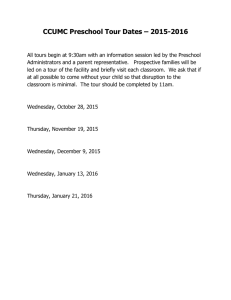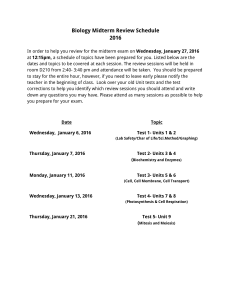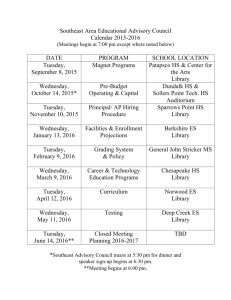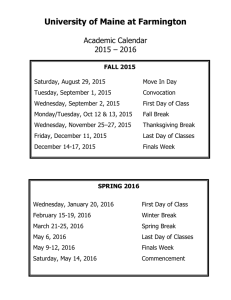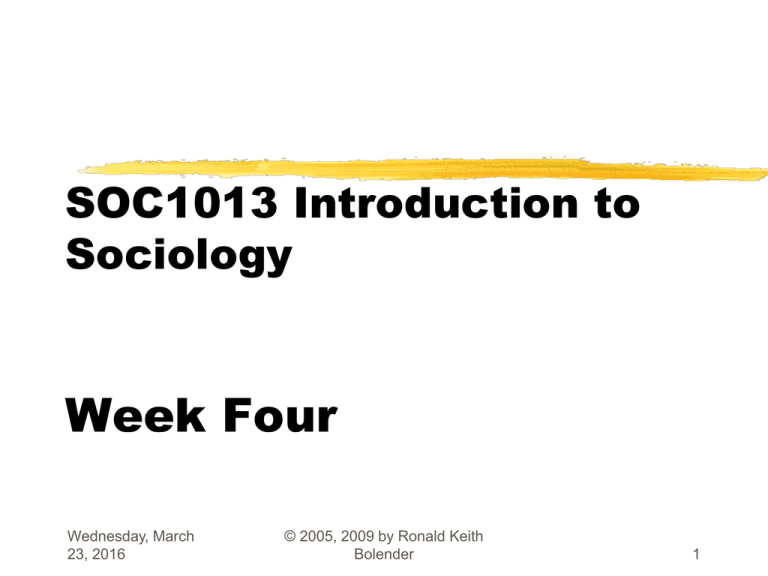
SOC1013 Introduction to
Sociology
Week Four
Wednesday, March
23, 2016
© 2005, 2009 by Ronald Keith
Bolender
1
Week Four
Compiled by:
Ronald Keith Bolender, Ed.D. (1996)
Nova Southeastern University
www.bolenderinitiatives.com
Wednesday, March
23, 2016
© 2005, 2009 by Ronald Keith
Bolender
2
Week Four
Important Copyright Note
This set of PowerPoint slides may only be
used in sections of SOC1013 Introduction
to Sociology where each student owns a
copy of The Meaning of Sociology (Charon
& Vigilant, 2009).
Wednesday, March
23, 2016
© 2005, 2009 by Ronald Keith
Bolender
3
Week Four
References
Charon, J. M., & Vigilant, L. G. (2009). The
meaning of sociology (8th ed.). Upper Saddle
River, NJ: Pearson Prentice Hall.
Cherlin, A. (1997). Public and private families.
New York: McGraw-Hill.
Hareven, T. K. (1992). Continuity and change in
family life. In L. S. Luedtke (Ed.), Making
America: The society and culture of the United
States (308-326). Chapel Hill: The University of
North Carolina Press.
Wednesday, March
23, 2016
© 2005, 2009 by Ronald Keith
Bolender
4
Week Four
Devotions
Wednesday, March
23, 2016
© 2005, 2009 by Ronald Keith
Bolender
5
Week Four:
ICA 4-1 Writing Assignment
ICA 4-1 In-class writing assignment over
HWA 4-1, HWA 4-2, and HWA 4-3
Purpose: To illustrate a basic understanding of
sociological concepts introduced in the reading
assignments for Week Four.
Grade: This assignment is worth a maximum of 25
points.
Content (maximum of 20 points): In addition to the
quality of the concepts and analysis presented—the
minimum length is 250 words.
Grammar, Spelling, and Sentence Structure (maximum
of 5 points)
Wednesday, March
23, 2016
© 2005, 2009 by Ronald Keith
Bolender
6
Week Four:
ICA 4-1 Writing Assignment
Instructions: Answer this question from
Chapter 12 Social Change.
How can a major change in one institution
(use the sociological definition of institution)
impact other institutions? Give a “good”
sociological example illustrating this
interdependence between various institutions.
PLEASE PRINT
Wednesday, March
23, 2016
© 2005, 2009 by Ronald Keith
Bolender
7
Week Four:
Chapter 11: Symbols, Self, and Mind: Our
Active Nature
Determinism
Sociologists tend to be what is sometimes called “deterministic.”
If a perspective is deterministic, this means that the cause of
human behavior is thought to be outside free choice.
Determinism is definitely part of what much of sociology is. It just
seems to “come with the territory” because the real purpose of
sociology (as well as all other sciences) is to understand what
causes something—what causes human action. The question does
not lend itself to an investigation of freedom and individuality.
Yet sociologists will almost always become defensive when people
charge that their perspective does not account for at least some
freedom.
Wednesday, March
23, 2016
© 2005, 2009 by Ronald Keith
Bolender
8
Week Four:
Chapter 11: Symbols, Self, and Mind: Our
Active Nature
The work of George Herbert Mead
wrote about the links between the
individual and society, and always
emphasized the interdependence of the
two. Society makes the human
being, yet the human being, in
turn, makes society. We are social
beings, Mead argued, but our most
important individual qualities (all of
which arise from society)—symbols,
self, and mind—also allow us to
exercise some control over our lives.
Wednesday, March
23, 2016
© 2005, 2009 by Ronald Keith
Bolender
9
Week Four:
Chapter 11: Symbols, Self, and Mind: Our
Active Nature
Individuality and Freedom
Perhaps the most important questions thinking
people ask concern the relationship between the
individual and society.
Are we simply the product of our social life?
Do we make free choices?
Do we have any impact on the direction of society?
Is there any real individuality?
Wednesday, March
23, 2016
© 2005, 2009 by Ronald Keith
Bolender
10
Week Four:
Chapter 11: Symbols, Self, and Mind: Our
Active Nature
A philosophy of freedom is central to our
political ideas.
Individualism is also central to the United States
culture.
Not all societies value freedom and
individualism. In some, commitment to kin is far
more important. In some, commitment to
tradition, God, or society itself overshadows
freedom or individuality.
Wednesday, March
23, 2016
© 2005, 2009 by Ronald Keith
Bolender
11
Week Four:
Chapter 11: Symbols, Self, and Mind: Our
Active Nature
It is important to separate freedom from
individuality.
Freedom means that the actor
actively makes choices and directs
himself or herself in situations. The
actor is in control of his or her own life.
This may mean the actor is an individual;
it may also mean the actor is like other
individuals.
Wednesday, March
23, 2016
© 2005, 2009 by Ronald Keith
Bolender
12
Week Four:
Chapter 11: Symbols, Self, and Mind: Our
Active Nature
Individuality means that the actor is
unique. The actor is different from others
around him or her. This may arise from
freedom: The actor may actively refuse to think
or act in a certain way simply because others do
so.
I may be an individual who flies off the handle all the
time, making me different from others around me,
but that does not mean I am free.
Wednesday, March
23, 2016
© 2005, 2009 by Ronald Keith
Bolender
13
Week Four:
Chapter 11: Symbols, Self, and Mind: Our
Active Nature
Freedom has to do with cause.
If freedom does exist, it exists when the
individual is somehow his or her own cause,
exercising control over self and situation.
Individuality has to do with differences.
When a person stands out, he or she is said
to be very different from others, and we
usually call that person an individual.
Wednesday, March
23, 2016
© 2005, 2009 by Ronald Keith
Bolender
14
Week Four:
Chapter 11: Symbols, Self, and Mind: Our
Active Nature
Individuality is like all other human qualities: It
arises in interaction with others. We are all
different—and some of us are very different—
partly because we each have a unique set of
interactions, positions, cultures, and
socialization experiences. We are all subject
to a different set of social controls. Each
actor faces a different set of influences; each is
the convergence of a different set of social
forces.
Wednesday, March
23, 2016
© 2005, 2009 by Ronald Keith
Bolender
15
Week Four:
Chapter 11: Symbols, Self, and Mind: Our
Active Nature
Causes of individualism
Each of us has a different interaction history and is
subject to a different set of social forces
Each of us is biologically different, and the reactions
of others to these differences also enter into what we
all become
Each of us because we have some freedom are able
to create our own uniqueness to some extent
Wednesday, March
23, 2016
© 2005, 2009 by Ronald Keith
Bolender
16
Week Four:
Chapter 11: Symbols, Self, and Mind: Our
Active Nature
The Origin of Human Freedom
George Herbert Mead believes that freedom,
like everything else about us, comes from
our social life. Humans are social to their very
core, and we are not only imprisoned by this
fact but also set free by it. It is responsible for
our ability to break out, to control our self, to
act back on society, and to direct our self away
from what the socializers and controllers want.
Wednesday, March
23, 2016
© 2005, 2009 by Ronald Keith
Bolender
17
Week Four:
Chapter 11: Symbols, Self, and Mind: Our
Active Nature
To understand this, we must understand that
other people, by socializing us to become what
they want, actually provide us with tools to
decide independently what we want. More
specifically, it is through socialization that the
individual takes on three important qualities:
symbol, self, and mind, and these, in turn,
become qualities that become the basis for
human freedom.
Wednesday, March
23, 2016
© 2005, 2009 by Ronald Keith
Bolender
18
Week Four:
Chapter 11: Symbols, Self, and Mind: Our
Active Nature
Human Beings Are Symbol Users
Human beings, totally helpless at birth, without
instinct to guide them, must rely on other
people—on socialization—to show them the way
to deal with situations. This is accomplished by
the child imitating the adult, through rewards
and punishments given by the adult, but most
of all through the words used by the adult to
identify the world, the person, the rules, the
patterns, and so on.
Wednesday, March
23, 2016
© 2005, 2009 by Ronald Keith
Bolender
19
Week Four:
Chapter 11: Symbols, Self, and Mind: Our
Active Nature
The Meaning of Symbols
Words are symbols. Indeed, the only
function of words is to be symbolic. That is
why they are created in the first place.
However, objects can be made into symbols
too (for example, a flower or ring, which may
mean friendship or love or marriage). Many
of our acts are also symbols.
Wednesday, March
23, 2016
© 2005, 2009 by Ronald Keith
Bolender
20
Week Four:
Chapter 11: Symbols, Self, and Mind: Our
Active Nature
Symbols are words, acts, and objects used
intentionally—on purpose—to communicate and
represent something.
Not all communication involves symbols. Almost all animals
communicate without symbols. The sounds or movements of
one acts as a stimulus to the other, which responds
automatically. For Mead, however, the special quality of
symbolic communication is the fact that the one who
communicates both understands his or her own
communication and intentionally communicates. This
makes it possible to apply the symbols we learn to thousands of
situations, conversations, letters we write, poetry we create,
and problems we have to solve.
Wednesday, March
23, 2016
© 2005, 2009 by Ronald Keith
Bolender
21
Week Four:
Chapter 11: Symbols, Self, and Mind: Our
Active Nature
The Importance of Symbols
Human social organization depends upon symbols.
Social organization demands that human beings
communicate with each other as they cooperate, as
problems are encountered and worked out.
The human individual depends on symbols.
Symbols are what we use to communicate with ourselves;
that is, most of our thinking consists of symbol use. It is
through word symbols that we analyze situations, define
them, apply our past experience, and predict the
consequences of our action. Symbol use means we are
problem solvers in our world; we plan our action rather than
just respond to stimuli.
Wednesday, March
23, 2016
© 2005, 2009 by Ronald Keith
Bolender
22
Week Four:
Chapter 11: Symbols, Self, and Mind: Our
Active Nature
Symbols and Freedom
Symbols are the basis for human thinking, and thinking in turn
is basic to what we do in situations. We do not just respond to
the world presented to us by others; we manipulate that world
in our heads with the use of symbols, and we act accordingly.
Rather than requiring mechanical robots or instinctive ants,
human social organization demands thinking actors. Part of the
“problem” with thinking actors is that they are difficult to control
completely, so actors within all social organization end up
questioning, criticizing, challenging, and shaping the direction of
their own lives in social organization. Symbols, then, as well
as capabilities they make possible in the human being
make us all into potentially free actors, at least to some
extent.
Wednesday, March
23, 2016
© 2005, 2009 by Ronald Keith
Bolender
23
Week Four:
Chapter 11: Symbols, Self, and Mind: Our
Active Nature
We Possess Self and Mind
Self simply means the person as object, an
object that the actor can look back on and act
on.
The conversation we all carry on with the self is
called thinking.
Selfhood means we are able to talk to self about self.
To possess a self also means that we can exercise
self-direction in situations.
Wednesday, March
23, 2016
© 2005, 2009 by Ronald Keith
Bolender
24
Week Four:
Chapter 11: Symbols, Self, and Mind: Our
Active Nature
Mind is thinking, all the conversation
the actor carries on with self. Mind is the
talking the actor does to himself or
herself. This activity involves all the ways
the actor points things out to self.
Wednesday, March
23, 2016
© 2005, 2009 by Ronald Keith
Bolender
25
Week Four:
Chapter 11: Symbols, Self, and Mind: Our
Active Nature
Symbols, self, and mind are easily
confused because they are so intimately
connected. Simply remember that
symbols are things the individual uses to
communicate (including communicating
with self), self is the object the individual
communicates to (with symbols), and
mind is all the action—with symbols—that
we engage in toward self.
Wednesday, March
23, 2016
© 2005, 2009 by Ronald Keith
Bolender
26
Week Four:
Chapter 11: Symbols, Self, and Mind: Our
Active Nature
If you would like to learn more about
Mead’s theory regarding symbols, self,
and mind, go to
www.bolenderinitiatives.com, click on
“Academics,” go to “Sociology,” and then
click on “George Herbert Mead.”
Wednesday, March
23, 2016
© 2005, 2009 by Ronald Keith
Bolender
27
Week Four:
Chapter 12: Social Change
Individual Change and Social Change
Individuals change. They change their
directions, their ideas, their friends, and their
values. As they change roles, they too change,
and as they change groups or communities,
they change again. Every organization we enter
means change because we are faced with new
kinds of controls, structure, culture, and social
institutions.
Wednesday, March
23, 2016
© 2005, 2009 by Ronald Keith
Bolender
28
Week Four:
Chapter 12: Social Change
So far in this course, we have focused on
stability and order in social structure. But
social organization also changes. Social
change is easily as important a topic in
organization as order and stability.
The question to be considered is: What causes
social patterns to change? There are many
factors, and sociologists differ as in which is the
most important.
Wednesday, March
23, 2016
© 2005, 2009 by Ronald Keith
Bolender
29
Week Four:
Chapter 12: Social Change
Acts of Individuals and Groups Change Organization
While we like to think that a single individual can change
organization—the reality is often otherwise. The paradox
is that those in the positions to bring about the most
change are least likely to desire change; having made it
to the top, they have the greatest investment in the
organization. Their goals, values, and identities will be
tied to it.
It is easy to complain about the conservatism of the
powerful in a social organization, but we too are
transformed by our new status positions as we rise in
the hierarchy. Thus the nature of social structure itself
works against the ability of individuals to have great
impact.
Wednesday, March
23, 2016
© 2005, 2009 by Ronald Keith
Bolender
30
Week Four:
Chapter 12: Social Change
Organized groups are likely to have more impact
on social organization.
When large numbers of people work
together in a loosely organized effort to
change society, they constitute a social
movement.
Social movements are more likely than
individuals to affect direct change in social
organization.
Wednesday, March
23, 2016
© 2005, 2009 by Ronald Keith
Bolender
31
Week Four:
Chapter 12: Social Change
Social Conflict Changes Organization
Organization can NEVER satisfy the needs and
interests of everyone equally; there is always
struggle over what it offers to its members (struggle
over rights, power, money, prestige, who pays taxes,
who is deviant, and what ideas and values shall be
adhered to). As long as human differences exist in
organized life—and this will always be so—there
will be social conflict; as long as there is social
conflict, there will be social change.
IMPORTANT CONCEPT
Wednesday, March
23, 2016
© 2005, 2009 by Ronald Keith
Bolender
32
Week Four:
Chapter 12: Social Change
External Social Organizations and Environments Change Social
Organization
The social and physical environments have two paths of influence on social
change. On one hand, they directly influence change: they favor some
classes, some institutions, some cultural values, ideas and rules. They
destroy others. Cities are destroyed by earthquakes or fire or plague;
changes in the climate destroy agriculture or alter the way people live. The
industrialists from the West open up trade in a rural society, and they bring
to power a rising middle class or they create a new industrialized urban
poor.
On the other hand, environmental changes bring about change indirectly.
They create social conflicts in society: scarcity brings struggle over what is
left to fight for, new classes rise up against the old, those who follow
tradition are fought against by those who believe in progress.
Wednesday, March
23, 2016
© 2005, 2009 by Ronald Keith
Bolender
33
Week Four:
Chapter 12: Social Change
Technology Changes Social Organization
Why do we act in the world the way we do?
Max Weber pointed out that much of the way
people do things can be divided into tradition
and rationality.
We act the way we do because that is the way
people like us have always acted (tradition).
We act the way we do because it works for the
problems we need to solve (rationality).
Wednesday, March
23, 2016
© 2005, 2009 by Ronald Keith
Bolender
34
Week Four:
Chapter 12: Social Change
Weber described modern society as
increasingly rational. IMPORTANT
CONCEPT
There is an increasing tendency to escape
traditional action and replace it with rational
action: the application of knowledge to solving
problems. This is the meaning of technology,
and although there has been technology in
every human society, modern life is thoroughly
technological, and wherever new technology
is introduced, change in society occurs.
Wednesday, March
23, 2016
© 2005, 2009 by Ronald Keith
Bolender
35
Week Four:
Chapter 12: Social Change
People do not normally create technology to change
society. Instead, they do it to solve a problem at hand.
They do it, for example, to conquer a disease or put up
a sturdier building. However, these developments
together have profound effects on the nature of
society, on its social structure, culture, and
institutions.
The development of birth control devices, whatever their
original purpose, has made a tremendous difference in a
woman’s ability to control her life, and this, in turn, has had
great effects on equality of men and women and the nature of
the family.
Wednesday, March
23, 2016
© 2005, 2009 by Ronald Keith
Bolender
36
Week Four:
Chapter 12: Social Change
Changes in Population Change Social Organization
Population change itself is an important cause of social
change, and it too contributes to social conflict and
further change.
Small towns become big towns, and big towns become
cities or metropolitan centers. Urban life alters society’s
occupational structure, its class system, and dominantminority group relations. Urban life alters the relationship
between men and women, giving the latter greater
opportunity to succeed in the economic and political
order. Urban life brings a change in leisure activities, level
of education, ideas, and values.
Wednesday, March
23, 2016
© 2005, 2009 by Ronald Keith
Bolender
37
Week Four:
Chapter 12: Social Change
If you would like to learn more about the impact
of population growth and concentration on
social change, go to
www.bolenderinitiatives.com, click on
“Academics,” then “Sociology,” and then click on
“Georg Simmel.” Within this section there is a
famous article called “The Metropolis and Mental
Life.” Simmel discusses how social change is
caused by urbanization and the growing
population.
Wednesday, March
23, 2016
© 2005, 2009 by Ronald Keith
Bolender
38
Week Four:
Chapter 12: Social Change
Change in Social Patterns Causes Change in Other
Social Patterns
As one institution changes, so do other institutions, because
institutions are interrelated.
As television becomes increasingly more important, public schools,
political campaigning, and the socialization of children are altered
considerably.
As institutions change, so do other aspects of culture, such as norms,
values, goals, and truth.
As professional sports becomes more central to society, competition and
striving to be number one become more important values in society. Also,
the belief that leisure should be directed at watching others perform,
becomes more accepted.
Wednesday, March
23, 2016
© 2005, 2009 by Ronald Keith
Bolender
39
Week Four:
Chapter 12: Social Change
As institutions change, so does social structure.
Changes in the institution of marriage alter the relationship
between men and women in society; changes in our tax system
(such as the end of the estate tax or the establishment of flat
tax) will have an important influence on the extent of inequality
in our class system.
As institutions change in society, smaller levels of social
organization are affected: communities, formal,
organizations, groups, dyads.
Bureaucratization in society influences individual formal
organizations to become increasingly bureaucratic. Increasing
legitimization of divorce in society affects individual familial
relationships to change in society.
Wednesday, March
23, 2016
© 2005, 2009 by Ronald Keith
Bolender
40
Week Four:
Chapter 12: Social Change
Changing culture also influences social change: It alters structure,
institutions, and other aspects of culture.
A classic analysis of how culture is a source of change was made by
Max Weber in The Protestant Ethic and the Spirit of Capitalism (1905).
Here Weber argued that the development of a Protestant religious
philosophy (a set of truths, values, norms, and goals) was
instrumental to the development of a capitalist-oriented middle class
in Europe (and thus the class structure). The middle class in turn
transformed many European societies to develop capitalist economic
institutions. Weber showed that a certain kind of Protestantism
(represented in the United States by the Puritans) taught a
culture that valued hard work, the belief that success in this
life was proof of election by God for salvation, and that an
important norm that people should follow is to save and
reinvest what they earn rather than to spend. This culture,
Weber, emphasized, encouraged the development of an economic
order that included its own culture, institutions, and structure.
Wednesday, March
23, 2016
© 2005, 2009 by Ronald Keith
Bolender
41
Week Four:
Chapter 12: Social Change
Summary
There is no easy way to understand
change. There are many causes of
change. Sociologists try to study change
by isolating tendencies, general directions,
and trends. Trends is a VERY important
aspect for study within sociology.
Wednesday, March
23, 2016
© 2005, 2009 by Ronald Keith
Bolender
42
Week Four:
Chapter 13: The Family in Society
The Importance of the Family to Sociology
Auguste Comte, the first sociologist, was
truly dedicated to the idea that society was
an entity in and of itself. Society is not
simply a bunch of individuals. In fact, he
went on, individuals have never existed
without society, and the basic unit of
society has never been the individual at all.
The basic unit of society is the group
we call the FAMILY because it is the
family that forms the individual and
makes society possible.
Wednesday, March
23, 2016
© 2005, 2009 by Ronald Keith
Bolender
43
Week Four:
Chapter 13: The Family in Society
It is the family that makes us social
beings ready to take on our positions, a
culture, and social institutions. It is
unimaginable, therefore, to even consider
the possibility for human society or the
human individual without considering the
role of the family.
Wednesday, March
23, 2016
© 2005, 2009 by Ronald Keith
Bolender
44
Week Four:
Chapter 13: The Family in Society
The study of family is truly a study of social
change. The rate of change in our family life
accelerated throughout the twentieth century. Modern
society has brought individualism and choice in our
lives, and this has affected what our families have
become. Many of our problems as individuals and as
society can be traced to the changes in the family, and
many of the benefits we enjoy can also be traced to
these family changes. Our attitudes toward unmarried
couples living together, premarital sex, women’s and
men’s roles, having children, and socializing children
have undergone considerable change. In both family
structure and sexuality, we regard more and more varied
behavior as normal and agree less and less about what
constitutes deviant behavior.
Wednesday, March
23, 2016
© 2005, 2009 by Ronald Keith
Bolender
45
Week Four:
Chapter 13: The Family in Society
Sociological Definition of Family
The family is a primary group that lives in a single
household whose universal function is to have the
primary responsibility for the socialization of children. It
also has important economic and social functions, and it
is important for placing children into the class system.
Increasingly, it has taken on important expressive
functions, where all the members are expected to find a
place of intimacy, love, and personal happiness.
Do not read “single household” as indicating ONLY “singleparent” households.
Wednesday, March
23, 2016
© 2005, 2009 by Ronald Keith
Bolender
46
Week Four:
Chapter 13: The Family in Society
The family:
A primary group in a household
The socialization function
Economic and social functions
The social class placement function
The expressive function
Wednesday, March
23, 2016
© 2005, 2009 by Ronald Keith
Bolender
47
Week Four:
Chapter 13: The Family in Society
Marriage as an Institution
Marriage is an excellent example of an
institution. We are born into a society that
regards marriage as an important groove to
follow. Although people can find personal
happiness and meaning without marriage, much
of how other people act toward us tells us that
we “just have to get married” to live productive
lives, and if we do not marry, there is something
wrong with us.
Wednesday, March
23, 2016
© 2005, 2009 by Ronald Keith
Bolender
48
Week Four:
Chapter 13: The Family in Society
In the early history of the United States,
marriage was strongly socialized in society.
Colonial American communities had bachelor
taxes, and single women who inherited land
were often required to marry soon after or lose
that land.
Benjamin Franklin expressed the wisdom of his day:
A single man “is an incomplete animal. He resembles
the odd half of a pair of scissors.”
Wednesday, March
23, 2016
© 2005, 2009 by Ronald Keith
Bolender
49
Week Four:
Chapter 13: The Family in Society
In modern America, there is less pressure
to marry than in Colonial America—
however, the institution of marriage is not
likely to disappear anytime soon.
Wednesday, March
23, 2016
© 2005, 2009 by Ronald Keith
Bolender
50
Week Four:
Chapter 13: The Family in Society
The changing structure of marriage
Owner-property
Before the age of industrialization (prior to the midnineteenth century), the woman was considered to be the
property of the man.
Head-complement
By the mid-nineteenth century the status of the woman
gradually changed from property to an individual with some
rights.
Senior-junior partners
Since World War II, the marriage relationship has become
increasingly equal in the United States.
Wednesday, March
23, 2016
© 2005, 2009 by Ronald Keith
Bolender
51
Week Four:
Chapter 13: The Family in Society
Marital Satisfaction
By emphasizing the expressive side of marriage, the twentieth
century has significantly altered the family in society. The
family is no longer held together simply by satisfying economic and
socialization needs. Instead, the emotional needs of each partner are
added; marriage is held together because it now provides
opportunities for each partner to have a friend, a listener, and a lover.
This added function in marriage produces a new set of
stresses on the marriage relationship. And now because
individual happiness becomes increasingly important to us, if marriage
does not meet these expectations, people will fill them elsewhere,
either outside the marriage or by divorce and remarriage. In a very
basic sense, the problem with modern marriage is that we
expect too much from it.
Wednesday, March
23, 2016
© 2005, 2009 by Ronald Keith
Bolender
52
Week Four:
Chapter 13: The Family in Society
The major historical change in family values has
been one from a collective view of the family to
one of individualization and sentiment. Over the
past several decades American families have been
experiencing an increasing emphasis on individual
priorities and preferences over collective family needs.
This individualization of family relations has also fed to an
exaggerated emphasis on emotional nurture, intimacy,
and privacy as the major base of family relationships. This
has eroded the resilience of the family and its ability to
withstand crises (Hareven, 1992, p. 317).
Whether or not this change is a good one depends on our
personal values, but undoubtedly, higher rates of divorce will be
one of its outcomes.
Wednesday, March
23, 2016
© 2005, 2009 by Ronald Keith
Bolender
53
Week Four:
Chapter 13: The Family in Society
Divorce
Divorce has been on the rise in American society since 1860 (and
accelerated in the 1960s and 1970s). The divorce rate has leveled off in
the 1980s and 1990s, but it does not seem to be going down
considerably. About half of today’s marriages in the United States will end
in divorce. This is one of the highest rates in the world, but other
industrialized nations are rapidly catching up to us. Many observers
attribute the high rates to industrialization and urbanization—
more specifically, to the ethic of individualism accompanying
these developments. In addition to this, increased equality in the
marriage relationship means that both parties have an equal voice in
whether the marriage lasts, and higher expectations for marriage as well
as longer life spans for the partners put additional strains on marriage.
Over time, as people turn to divorce as a solution to an unsatisfactory
marriage, divorce becomes more of an acceptable solution; divorce
becomes a legitimate institution.
Wednesday, March
23, 2016
© 2005, 2009 by Ronald Keith
Bolender
54
Week Four:
Chapter 13: The Family in Society
Children and Socialization in the Family
In most societies and in most periods of history,
to marry was to have children. Indeed, for most
human beings, children are a central part of life. Modern
Western industrial society is different. Having children,
like most other things, has become an option; it is not
(especially with the new birth control technology)
something taken for granted. In an age of
individualism, people will calculate rewards and
costs associated with having and raising children,
and many will decide that the cost is too high.
One of the results is the trend toward smaller families
(two children) in society; another is the rising number of
childless marriages.
Wednesday, March
23, 2016
© 2005, 2009 by Ronald Keith
Bolender
55
Week Four:
Chapter 13: The Family in Society
The family remains a very important agency for
the socialization of children. We take on human
qualities through interactions in the family. The family
teaches us symbols, helps shape our self, constitutes our
first role models and our first introduction to the rules of
society, and forms our earliest perspectives on the world.
The family teaches us who we are and gives us the love
and security necessary to make us independent adults.
Through it all, most of us become social beings, members
of society who are able to cooperate with others, and who
act according to a conscience heavily influenced by rules
we learn within the family. The family remains central to
both the individual and society. It is still, to the language
of sociologists, THE primary group.
Wednesday, March
23, 2016
© 2005, 2009 by Ronald Keith
Bolender
56
Week Four:
Chapter 13: The Family in Society
Individual Choice and the Changing Family
The modern American family is undergoing profound and rapid
change. This is not simply because of a conspiracy by some group
trying to destroy our society, nor is it simply caused by television,
declining morality, or declining schools. And this change is not simply
the result of the declining importance of the family, either. The real
change is toward a state of deinstitutionalization (toward a
society in which personal choice in how to live prevails)
rather than an end to the family itself. People are deciding what
to do with their lives—before and during marriage—rather than being
told what to do by society. There is an increasing legitimacy of
choice rather than simply a certain groove to follow.
Wednesday, March
23, 2016
© 2005, 2009 by Ronald Keith
Bolender
57
Week Four:
Chapter 13: The Family in Society
This is especially true of the middle class:
Marriage must now compete with alternatives such as staying in
school longer to obtain a higher degree, taking more time to
develop a career, living with a partner without marrying, or having
children outside of marriage. Among middle class young adults,
this competition is increasingly judged by a single criterion: selffulfillment. And by this criterion, marriage does not always come
out the winner.
Most Americans still want to marry, but have less of a need to do
so.
Most want children, but they also value other uses of their time
and money.
Many are ambivalent about marriage, at once drawn by its
promise of intimacy and wary of its commitments and constraints.
(Cherlin, 1997, p. 8)
Wednesday, March
23, 2016
© 2005, 2009 by Ronald Keith
Bolender
58
Week Four:
Chapter 14: Religion, Society, and the
Individual
The Functions of Religion in Society
(per Emile Durkheim)
Religion and the Creation of the Sacred
Religion’s Creation and Function is Social
Religion Creates and Upholds the Morality
of Society
Religion Is Important for the Individual
Wednesday, March
23, 2016
© 2005, 2009 by Ronald Keith
Bolender
59
Week Four:
ICA 4-2 In-class Work Session
ICA 4-2 In-class working session on the HWA 5-1 SocioAutobiography Project
The facilitating instructor will assign students into groups.
The purpose of this work session is to edit the COMPLETE drafts from the
“HWA 4-5 Write a COMPLETE draft of the HWA 5-1 Socio-Autobiography
Project” assignment.
Each group member should read all drafts from the group.
Each student is to constructively criticize and comprehensively edit all
drafts.
Students are ultimately responsible for their own work. The group is providing
helping suggestions to consider in revising the COMPLETE draft into the final
paper (HWA 5-1 Socio-Autobiography Project).
The facilitating instructor will be serving as “consultant” on this project.
She/he will move around from group to group during this in-class working
session.
For those who complete the minimum requirements of ICA 4-2 before the
rest of the class, the remaining time should be spent writing.
This is a very important work session!
Wednesday, March
23, 2016
© 2005, 2009 by Ronald Keith
Bolender
60
Week Four
Review homework assignments (HWAs)
for Week Five.
Wednesday, March
23, 2016
© 2005, 2009 by Ronald Keith
Bolender
61

